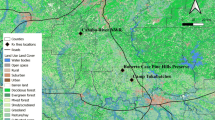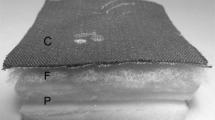Abstract
A study of firefighter exposure was undertaken as part of a larger smoke exposure study. Teams of Chicago Fire Department firefighters were issued equipment for monitoring exposure conditions during structural fire suppression activity (knockdown and overhaul) and search and rescue operations. Potential inhalation exposure was characterized by outfitting firefighters with direct-reading gas meters and personal cascade impactors. The gas meters used electrochemical sensors to detect six gases of interest: carbon monoxide (CO), hydrogen sulfide (H2S), sulfur dioxide (SO2), ammonia (NH3), nitrogen dioxide (NO2) and hydrogen cyanide (HCN). The personal cascade impactors were four stage units with 9.8 μm, 3.5 μm, 0.93 μm and 0.52 μm particle size cut points. Size-segregated particles collected on the impactor plates were analyzed for smoke particle weight distribution and for inorganic element content by inductively coupled plasma-mass spectroscopy (ICP-MS). Gloves and hoods were issued to teams of firefighters as part of their standard turnout ensemble and collected at regular intervals for chemical evaluation of accumulated combustion residue. Sections of the hoods and gloves were analyzed for inorganic element content by ICP-MS, mercury by cold vapor atomic absorption spectroscopy (CVAAS), and polynuclear aromatic hydrocarbons (PAHs) and other organic compounds by gas chromatography-mass spectroscopy (GC–MS). Findings indicated that firefighters are exposed to:
-
Smoke particles, especially in the submicron size range.
-
Concentrations of toxic gases in excess of NIOSH published IDLH (Immediately Dangerous to Life or Health) and STEL (Short Term Exposure Limit) levels.
-
Chemical species that are either known or suspected potential carcinogens as classified by NIOSH, OSHA, and ACGIH.














Similar content being viewed by others
Notes
The most common elements present in the earth’s crust are oxygen (46.6%), silicon (27.7%), aluminum (8.1%), iron (5.0%), calcium (3.6%), sodium (2.8%), potassium (2.6%), magnesium (2.1%). Source: “Windows to the Universe”, University Corporation for Atmospheric Research.
Effective August 14, 2011.
References
Ahrens M (2009) Home structure fires. Fire Analysis and Research Division, National Fire Protection Association, Quincy
Karter MJ Jr, Molis JL (2007) Fire fighter injuries for 2006. NFPA reports. NFPA J, Nov/Dec
Melicow MM. (1775) Percival Pott (1713–1788): 200th anniversary of first report of occupation-induced cancer of scrotum in chimney sweepers. Urology; 6:745-9
Hansen ES (1990) A Ccohort study on the mortality of firefighters. Br J Ind Med; 47(12): 805–809
Rosenstock L, Demers P (1991) Northwest Firefighters Mortality Study: 1945–1989 final report. United States Fire Administration Document FA-105. Federal Emergency Management Agency, Washington
LeMasters GK, Genaidy AM, Succop P, Deddens J, Sobeih T, Barriera-Viruet H, Dunning K, Lockey J (2006) Cancer risk among firefighters: a review and meta-analysis of 32 studies. J Occup Environ Med; 48(11):1189-202
Elihn K, Berg P (2009) Ultrafine particle characteristics in seven industrial plants. Ann Occup Hyg; 53(5):475-84
Brandt-Rauf PW, Fallon Jr LF, Tarantini T, Idema C, Andrews L (1988) Health Hazards of Fire Fighters: exposure assessment. Br J Ind Med; 45(9): 606–612
Edelman P, Osterloh J, Pirkle J, Caudill SP, Grainger J, Jones R, Blount B, Calafat A, Turner W, Feldman D, Baron S, Bernard B, Lushniak BD, Kelly K, Prezant D (2003) Biomonitoring of Chemical Exposure among New York City Firefighters Responding to the World Trade Center Fire and Collapse. Environmental Health Perspectives; 111(16): 1906-1911
Glueck CJ, Kelley W, Wang P, Gartside PS, Black D, Tracy T (1996) Risk factors for coronary heart disease among firefighters in Cincinnati. Am J Ind Med; 30(3):331-40
Ide CW (2000) A longitudinal survey of the evolution of some cardiovascular risk factors during the careers of male firefighters retiring from Strathclyde Fire Brigade from 1985–1994. Scott Med J; 45(3):79-83
Holmes AL, Wise SS, Wise JP Sr. (2008) Carcinogenicity of hexavalent chromium. Indian J Med Res; 128(4):353-72
Zhao J, Shi X, Castranova V, Ding M (2009) Occupational toxicology of nickel and nickel compounds. J Environ Pathol Toxicol Oncol; 28(3):177-208
Brook RD (2008) Cardiovascular effects of air pollution. Clin Sci; 115:175-187
Dockery DW, Luttman-Gibson H, Rich DQ (2005) Association of air pollution with increased incidence of ventricular tachyarrhythmias recorded by implanted cardioverter defibrillators. Envron Health Perspect; 113:670-674
Peters A, Wichmann HE, Tuch T, Heinrich J, Heyder J (1997) Respiratory effects are associated with the number of ultrafine particles. Am J Resp Crit Care Med; 155:1376-1383
Chalupa DC, Morrow PE, Oberdörster G, Utell MJ, Frampton MW (2004) Ultrafine particle deposition in subjects with asthma. Env Health Perspect; 112:879-882
Burgess J and Crutchfield C (1995) Tucson Fire Fighter Exposure to Products of Combustion: A Risk Assessment. Appl Occup Environ Hyg; 10(1):37-42
Fabian TZ, Borgerson JL, Gandhi PD (2010) Characterization of combustion products from flaming materials. In: Proceedings of Interflam 2010 fire science and engineering conference; 1909–1923
Baxter CS, Ross CS, Fabian T, Borgerson JL, Shawon J, Gandhi PD, Dalton JM, Lockey JE (2010) Ultrafine Particle Exposure During Fire Suppression—Is It an Important Contributory Factor for Coronary Heart Disease in Firefighters?. JOEM; 52(8): 791-6
Fabian TZ, Borgerson JL, Kerber SK, Gandhi PD, Baxter CS, Ross CS, Lockey JE, Dalton JM (2010) Firefighter exposure to smoke particulates (DHS AFG Grant #EMW-2007-FP-02093): final report. Underwriters Laboratories Inc, Northbrook
Fabian TZ, Gandhi PD, Patty PE, Chapin JT (2009) Characterization of combustion products under flaming and non-flaming conditions. In: Proceedings of fire & materials 2009 11th international conference
Fabian TZ, Gandhi PD, Patty PE, Chapin JT (2007) UL-FPRF smoke characterization project: final report. Underwriters Laboratories Inc., Northbrook
Acknowledgments
This research was funded by the Department of Homeland Security AFG Fire Prevention & Safety Grants program under grant number EMW-2007-FP-02093 and conducted jointly by Underwriters Laboratories Inc, the Chicago Fire Department, and the University Of Cincinnati College Of Medicine. The authors wish to express their gratitude to the fine men and women of the Chicago Fire Department and the laboratory staff of Underwriters Laboratories who have contributed to and worked on this project.
Author information
Authors and Affiliations
Corresponding author
Rights and permissions
About this article
Cite this article
Fabian, T.Z., Borgerson, J.L., Gandhi, P.D. et al. Characterization of Firefighter Smoke Exposure. Fire Technol 50, 993–1019 (2014). https://doi.org/10.1007/s10694-011-0212-2
Received:
Accepted:
Published:
Issue Date:
DOI: https://doi.org/10.1007/s10694-011-0212-2




